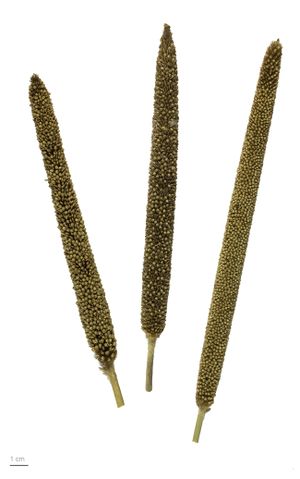Note: This is a project under development. The articles on this wiki are just being initiated and broadly incomplete. You can Help creating new pages.
Pennisetum glaucum
Pearl millet [1] (Pennisetum glaucum) is the most widely grown type of millet. It has been grown in Africa and the Indian subcontinent since prehistoric times. The center of diversity, and suggested area of domestication, for the crop is in the Sahel zone of West Africa. Recent archaeobotanical research has confirmed the presence of domesticated pearl millet on the Sahel zone of northern Mali between 2500 and 2000 BC.Cultivation subsequently spread and moved overseas to India. The earliest archaeological records in India date to around 2000 BC, and it spread rapidly through India reaching South India by 1500 BC, based on evidence from the site of Hallur. Cultivation also spread throughout eastern and southern parts of Africa. Pearl millet is widely grown in the northeastern part of Nigeria (especially in Borno and Yobe states). It is a major source of food to the local villagers of that region. The crop grows easily in that region due to its ability to withstand harsh weather conditions like drought and flood. Records exist for cultivation of pearl millet in the United States in the 1850s, and the crop was introduced into Brazil in the 1960s.
USES
- Millet is alkaline and it digests easily.
- The Hunzas – who live in a remote area of the Himalayan foothills and are known for their excellent health and longevity – enjoy millet as a staple in their diet.
- Millet will hydrate your colon to keep you from being constipated.
- Millet acts as a prebiotic feeding microflora in your inner ecosystem.
- The serotonin in millet is calming to your moods.
- Millet is a smart carb with lots of fiber and low simple sugars. Because of this it has a relatively low glycemic index and has been shown to produce lower blood sugar levels than wheat or rice.
- Magnesium in millet can help reduce the effects of migraines and heart attacks.
- Niacin (vitamin B3) in millet can help lower cholesterol.
- Millet consumption decreases triglycerides and C-reactive protein. Scientists in Seoul, South Korea concluded that millet may be useful in preventing cardiovascular disease. Nutrition Research. April 2010; 30(4):290-6.
- All millet varieties show high antioxidant activity. A team of biochemists analyzed the antioxidant activity; all varieties showed high antioxidant activity. Journal of Agricultural and Food Chemistry, 9 June 2010; 58(11):6706-14.
- Millet is gluten-free and non-allergenic. A great grain for sensitive individuals.
- Millet’s high protein content (15 percent) makes is a substantial addition to a vegetarian diet.
Common name
- English - Pearl millet
- Kannada - ಸಜ್ಜೆ
- Hindi - बाजरा
